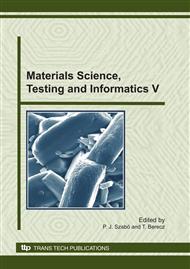p.289
p.295
p.301
p.307
p.313
p.319
p.325
p.331
p.337
Mechanical Testing of Si3N4/SiC/Graphite Ceramic Composites
Abstract:
Pin-on-disc tribological tests were performed on Si3N4/SiC/graphite ceramic composites with 5N applied load, at room temperature in dry conditions. Tests were completed with microhardness tests (F=10N), indentation fracture toughness tests (F=100N), furthermore morphological analyses of the wear tracks by SEM. Based on SEM pictures of the wear traces the main damage mechanism could be identified as an abrasive wear. The purpose of the paper is to model the abrasive wear of the given composites. For this reason lateral crack chipping model suggested by Evans and Marshall for Si3N4 ceramics was used for the assessment of the worn volume of the abrasive wear process. The model has been applied with the aim of validating it
Info:
Periodical:
Pages:
313-318
Citation:
Online since:
September 2010
Authors:
Price:
Сopyright:
© 2010 Trans Tech Publications Ltd. All Rights Reserved
Share:
Citation:


